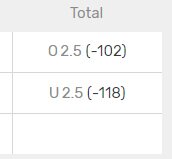 Author:
Jeremy Olson
| Last Updated:
August 2025
Author:
Jeremy Olson
| Last Updated:
August 2025
Expected value, or simply EV in sports betting, is a basic concept at its core. The idea is that you look for bets with positive expected value (+EV) to gain a theoretical advantage.
Sounds easy enough, but how do you determine positive EV in sports betting? And why does expected value matter so much?
Knowing these answers is part of what separates sharps from casual bettors. Let’s discuss more on EV sports betting, calculating it, how it compares to closed line value, and common mistakes.
Expected value is the theoretical long-term value that you get from making a particular bet. It measures the true odds of a wager versus the bookie’s odds.
Your goal is to research and find positive EV so that you’re continually making smart wagers. By contrast, negative expected value (-EV) means you’re placing bets that will theoretically lose money.
An easy way to understand the difference is by looking at the common 10% vig that sportsbooks charge on spreads. This 10% juice leads to -110 odds, which require you to win 52.4% of your bets to break even.
If you think a spread (-110) has better than a 52.4% chance of winning, then you’re making a +EV bet. Assuming you determine that it doesn’t, you should avoid the wager because it’s -EV.
We’ll provide in-depth examples on how EV betting works later, but the above description gives you a basic idea.
How to Calculate Expected ValueThe first step to knowing how to calculate expected value is understanding the following formula:
Like other sports betting formulas, this one might seem confusing at first. It’s actually pretty easy to understand, though, when you break it down.
The probability of an outcome winning or losing is based on your research. You must look at various factors (e.g., injuries, statistical trends) to determine the true odds.
The amount that you could win or lose is rather simple. You use your bet size to determine how much you can win depending on the odds. For example, a $100 bet at +150 odds would pay $150 (left side of the formula).
The amount you could possibly lose is simply your wager size. If you risk $100, then your potential loss is $100 (right side of formula).
Let’s put the formula into action with some examples involving +EV and -EV situations. We’ll start with spotting +EV at sports betting sites:
You see a player prop on if Giannis Antetokounmpo will score 30+ points.
Let’s plug the numbers in:
You may do a more detailed analysis beyond looking at how many times Giannis has gone for 30. Our point is simply to show a situation that could result in positive value.
Of course, sports betting is filled with many unfavorable wagers. Here’s an example of a -EV scenario:
Let’s use the formula now:
Reading about EV is cool, but seeing it play out with your own numbers is way better. This calculator lets you test a bet before you make it. All you need to do is enter the odds, your win probability, and your bet size.
Once you hit calculate, you’ll see if the wager is positive EV or negative EV. Think of it as a quick gut check before locking in your play. Sharps use this type of math every day to spot small edges that add up over time.
The beauty of EV is in the long run. One bet might not matter, but stacking the right side of the math again and again is where bankrolls grow. Use this sports betting EV calculator to train your eye and make sharper calls on the bets you actually fire.
Focusing on EV sports betting doesn’t guarantee winnings, but it can move you closer to success. This concept helps you spot potential value and make informed wagers while staying away from bad opportunities.
EV and closed line value (CLV) both involve trying to find value and boost your win rate. However, they accomplish this goal in different ways.
CLV measures the gap between the odds you bet at compared to the closing line. The goal is to wager at better prices early rather than waiting for potentially unfavorable odds later.
Let’s say you bet on the Boston Red Sox at -135 shortly after sportsbooks release their lines. The closing line is -160, meaning you theoretically gain -25 in odds value without considering vig.
The main difference between these concepts is what value they identify. With EV, you’re considering true win probabilities and how they compare to potential wins and losses. CLV focuses on how well you’re doing at beating the closing line.
How to Find Positive EV Sports BetsObviously, you don’t have time to apply EV math to every line at your favorite sport. The following steps will help you narrow down potential +EV wagers:

We recommend specializing in certain leagues and bet types, rather than trying to use EV on anything and everything. For example, you might hone your efforts on NBA player and team props. This specialization can help you develop more expertise and better assess true odds.

Line shopping is just as important with EV sports betting as it is any other time. You can improve positive expected value situations even more by finding better odds. Even small moves (e.g., +150 to +155) become valuable long term when you repeatedly make them.

You’ll want to know the key info and stats to research for win/loss probabilities. For example, you might consider a running back’s rushing avg. per game, recent performances, and opponent/defense for a rushing yardage prop.

The Kelly Criterion is a tried-and-true method to decide how many units to risk on +EV sports bets. You can also develop your own system based on your risk tolerance.
Expected value can definitely help your betting efforts when done properly. It can also hurt, though, if you’re bad at applying EV.
Here are common mistakes to avoid when calculating expected value:

Finding the true odds of a bet—vs what the sportsbook has posted—isn’t a guessing game. You should study stats, trends, and other key factors to see if your odds differ from the bookie.

We’ve never had much success turning -110 odds into value on a consistent basis. In fact, we often find that these lines have true probabilities in the 45-50% range. These percentages won’t cut it when you need a 52.4% rate just to stay even at -110.

The correct way to calculate EV for parlays involves finding the expected value for each individual leg. The goal is to ensure every leg has +EV, not just the majority of them.

Some bettors prioritize winning each wager over +EV. They typically apply the expected value formula to heavy favorites and bet even if their EV is negative. The goal isn’t to win one bet, it’s to consistently place wagers with positive value.
EV in sports betting requires a slight learning curve and some diligence, but it can definitely pay off. This approach will help you find favorable bets, increase your long-term winnings, and become a disciplined bettor.
We suggest considering player and team props if you’re going to dive into this world. We typically find +EV more often with these bet types versus others like spreads and totals.
You might be ready to try your hand at EV sports betting. If so, check out our picks for the top sports betting sites today.

Jeremy Olson has been writing about gambling for 20 years. He became interested in the writing side of gambling after playing poker and blackjack extensively. He now spends most of his time covering online casinos and sports betting. When he’s not writing, Jeremy likes listening to audiobooks and podcasts.

